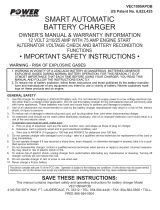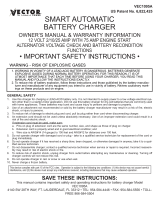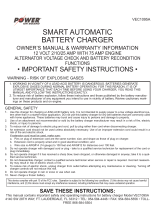Page is loading ...

1
• Pins on plug of extension cord are the same number,
size, and shape as those of plug on charger.
• Extension cord is properly wired and in good electrical
condition.
• Wire size is large enough for AC ampere rating of charger,
as specified below:
Length of cord (feet): 25 50 100 150
AWG size of cord: 18 16 12 10
11. Always charge battery in a well-ventilated area.
NEVER operate in a closed-in or restricted area without
adequate ventilation.
WARNING: Risk of explosive gas.
12. Locate charger as far away from battery as DC charger
cables permit.
13. Do not expose charger to rain or snow.
14. NEVER charge a frozen battery. If battery fluid (electrolyte)
is frozen, bring into a warm area to thaw before charging.
15. NEVER allow battery acid to drip on charger when reading
specific gravity or filling battery.
16. NEVER set a battery on top of charger.
17. NEVER place charger directly above battery being charged.
Gases from battery will corrode and damage charger.
18. NEVER touch the battery clamps together when the charger
is energized.
19. NEVER crank engine with charger attached to battery.
WARNING: Battery chargers get hot during operation and
must have proper ventilation. Air needs to flow around entire
charger. Do not set on flammable items like carpeting,
upholstery, paper, cardboard, etc. Will damage leather and
melt plastic and rubber.
1. Before you use your battery charger, be sure to read all
instructions and cautions printed on:
• Battery Charger
• Battery
• Vehicle or unit using battery
2. Use battery charger on LEAD ACID type rechargeable
batteries only, such as used on race cars. Charger is not
intended to supply power to low-voltage electrical system
other than in an automotive application.
WARNING: Do not use battery charger for charging dry-
cell batteries that are commonly used with home appliances.
These batteries may burst and cause injury to persons and
damage to property.
3. Use only attachments recommended or sold by
manufacturer. Use of non-recommended attachments may
result in fire, electric shock, or injury.
4. When disconnecting the battery charger, pull by the plug
not by the cord. Pulling on the cord may cause damage to
cord or plug.
5. Locate battery power cord so it cannot be stepped on, tripped
over, or subjected to damage or stress.
6. Do not operate charger with damaged cord or plug. Have
cord replaced immediately.
7. Do not operate charger if it has received a sharp blow, been
dropped, or otherwise damaged in any way. Take it to a
qualified professional for inspection and repair.
8. Do not disassemble charger. Take it to a qualified
professional when service or repair is required. Incorrect
reassembly may result in electric shock or fire.
9. To reduce risk of electric shock, unplug charger from outlet
before attempting any maintenance or cleaning.
10. Do not use an extension cord unless absolutely necessary.
Use of an improper extension cord could result in fire or
electric shock. If an extension cord must be used, make
sure that:
Read Rules for Safe Operation and Instructions Carefully
Working in vicinity of a lead-acid battery is dangerous. Batteries generate explosive gases during normal
battery operation. For this reason, it is of utmost importance that each time before using your charger, you
read this manual and follow the instructions exactly.
–Save–
Important Safety Instructions
WARNING: Handling the cord on this product or cords associated with accessories sold with this product, will expose you to lead, a
chemical known to the State of California to cause cancer and birth defects or other reproductive harm.
Wash hands after handling.
A. GENERAL BATTERY SAFETY
00-99-000540/0705
Send Warranty Product Repairs to: Schumacher Electric Corporation, 1025 E. Thompson, Hoopeston, IL 60942-0280
Call Customer Service if you have questions: 1-800-621-5485
INSTRUCTION MANUAL
Model: PSC-2516A
25 AMP Fully Automatic Battery Charger
For 16 Volt AGM Batteries

2
1. WARNING: Wear complete eye protection and clothing
protection when working with lead-acid batteries.
2. Make sure someone is within range of your voice or close
enough to come to your aid when you work with or near a
lead-acid battery.
3. Have plenty of fresh water and soap nearby for use if battery
acid contacts skin, clothing, or eyes. If battery acid contacts
skin or clothing, wash immediately with soap and water.
4. Avoid touching your eyes while working with a battery. Acid
particles (corrosion) may get into your eyes! If acid enters
your eye, immediately flood eye with running cold water for
at least 10 minutes. Get medical attention immediately.
5. Remove all personal metal items such as rings, bracelets,
necklaces, and watches when working with a lead-acid
battery. A lead-acid battery can produce a short-circuit
current high enough to weld a ring (or the like) to metal,
causing a severe burn.
6. Take care not to drop a metal tool or other metal onto the
battery. Metal may cause sparking or short circuit the battery
or another electrical device. Sparking may cause an
explosion.
7. Always operate battery charger in an open, well- ventilated
area.
8. NEVER smoke or allow a spark or flame in the vicinity of
the battery or engine. Batteries generate explosive gases!
LED Indicators: The battery charger has three LED lights. They
indicate different functions.
RED LED - A steady glow indicates POWER ON. Red LED
flashes if there is a problem. (i.e. battery isn't charged within 8
hours).
YELLOW LED - A steady glow indicates proper connection to
the battery. Flashing yellow indicates no connection or reverse
connection.
This battery charger is equipped with a self-resetting circuit
breaker. This device protects the charger from temporary
overloads. In the event of an overload, the circuit breaker will
trip open and after a short cooling off period will reset
automatically. This process is known as cycling and can be
recognized by an audible clicking sound.
1. Make sure you have a 16 volt lead-acid battery.
2. Clean battery terminals. Take care to keep corrosion from
coming in contact with your eyes.
3. If required, add distilled water in each cell until battery acid
reaches levels specified by battery manufacturer. This helps
purge excessive gas from cells. Do not overfill. For a battery
without cell caps, carefully follow manufacturer's recharging
instructions.
4. Study all battery manufacturer's specific precautions, such
as removing or not removing cell caps while charging, and
recommended rates of charge.
5. Be sure area around battery is well ventilated while battery
is being charged. Gas can be forcefully blown away by using
a piece of cardboard or other non-metallic material as a
fan.
6. If necessary to remove battery from vehicle to charge,
always remove grounded terminal from battery first. Make
sure all accessories in the vehicle are off, so as not to cause
an arc.
7. A marine (boat) battery must be removed and charged on
shore. To charge it on board requires equipment specially
designed for marine use.
B. PERSONAL PRECAUTIONS AND SAFETY
C. PREPARING TO CHARGE
D. LED DISPLAY
GREEN LED - A steady glow indicates that Float-mode
Monitoring is keeping your battery maintained at full charge.
As a safety precaution, after 24-hours of charging, the charger
automatically switchs OFF.
E. CIRCUIT BREAKER
NOTE: Clicking sound is normal. Wait until charger automatically
resets itself.
CAUTION: Persistent clicking (more than 30 minutes) may
indicate reverse connection or shorted battery cells. (See
TROUBLESHOOTING)

3
When charging battery out of the vehicle, take care to determine the battery type. To reduce risk of a spark near battery, follow these
steps when battery is outside vehicle. WARNING: A spark near battery may cause battery explosion. WARNING: When removing battery
from vehicle or boat, disconnect grounded post first. When disconnecting, make sure all accessories are off, so as not to cause an arc.
(NOTE: A marine (boat) battery must be removed and charged on shore. (To charge on board requires special equipment designed for
marine use.) WARNING: When reinstalling battery, attach the ground post first.
1. Perform these steps with the ON/OFF switch in the OFF
position.
2. Check polarity of battery posts. Battery case will be marked
by each post: POSITIVE (POS, P, +) and NEGATIVE (NEG,
N, -). NOTE: The positive battery post usually has a larger
diameter than the negative post.
3. Attach a 24-inch long (or longer) 6-gauge (AWG) insulated
battery cable to NEGATIVE (NEG, N, -) battery post.
(Purchase cable separately.)
4. Connect POSITIVE (RED) charger clamp to POSITIVE
(POS, P, +) battery post. Rock clamp back and forth to
make good connection.
5. Position yourself and free end of 24-inch cable as far away
from battery as possible. Then connect NEGATIVE (BLACK)
charger clamp to free end of cable. WARNING: Do not face
battery when making final connection. Rock clamp back
and forth to make a good connection.
FIGURE 1 shows the connection.
6. Plug charger AC cord into 120 volt outlet.
7. Select ON position on ON/OFF switch.
8. When battery is fully charged, push ON/OFF switch to OFF,
unplug charger from AC power source.
9. When battery is fully charged and charger is unplugged,
(1) remove clamp from end of 24-inch long cable connected
to NEGATIVE battery post, then (2) remove clamp from
Positive battery post, in that order.
10. Clean and store battery charger.
1. Perform these steps with the ON/OFF switch in the OFF
position.
2. Position AC power cord and DC charging cords to reduce
risk of damage by hood, door, or moving engine parts.
3. Stay clear of fan blades, belts, pulleys, and other parts that
can cause injury.
4. Check polarity of battery posts. Battery case will be marked
by each post: POSITIVE (POS, P, +) and NEGATIVE (NEG,
N, -). NOTE: The positive battery post usually has a larger
diameter than the negative post.
5. Determine which post of battery is grounded (connected)
to chassis. NOTE: The negative post is normally grounded.
NEGATIVE GROUNDED POST
6A. For negative-grounded vehicle, connect POSITIVE (RED)
clamp from battery charger to POSITIVE (POS, P, +)
ungrounded post of battery. Connect NEGATIVE (BLACK)
clamp to vehicle chassis or engine block away from battery.
Connect to a heavy-gage metal part of the frame or engine
block.
WARNING: Do not connect clamp to carburetor, fuel lines,
or sheet-metal body parts. NOTE: Attach clamps to battery
post and twist or rock back and forth several times to make
a good connection. This tends to keep clamps from slipping
off terminals and helps to reduce risk of sparking.
FIGURE 2 shows connections for a negative-grounded
battery.
FIGURE 1: CONNECT NEGATIVE BATTERY CLAMP
TO 24-INCH CABLE END
BATTERY
POSITIVE NEGATIVE
24", 6 GUAGE
CABLE
POWER
CORD
TO GROUNDED
POWER OUTLET
BATTERY CHARGER
+-
GROUND
(NEG)
FIGURE 2: CONNECTION TO NEGATIVE
GROUNDED BATTERY
POSITIVE GROUNDED POST
6B. For positive-grounded vehicle, connect NEGATIVE (BLACK)
clamp from battery charger to NEGATIVE (NEG, N, -)
ungrounded post of battery. Connect POSITIVE (RED)
clamp to vehicle chassis or engine block away from battery.
Connect to a heavy-gauge metal part of the frame or engine
block.
7. Plug charger AC cord into a grounded 120 volt outlet.
8. Select the ON position on the ON/OFF switch.
9. When battery is fully charged, push the ON/OFF switch to
OFF, unplug charger from AC power source.
10. Remove charger clamps from (1) chassis and (2) battery
post, in that order.
11. Clean and store battery charger.
When charging battery in vehicle, take care to determine the battery type and which pole is grounded. To reduce risk of a spark near
battery, follow these steps when battery is inside vehicle. WARNING: A spark near the battery may cause battery explosion.
F. OPERATING INSTRUCTIONS: CHARGING BATTERY OUT OF THE VEHICLE
G. OPERATING INSTRUCTIONS: CHARGING BATTERY IN VEHICLE

4
PROBLEM POSSIBLE SOLUTION
Red LED doesn't light Charger is not plugged in Plug in.
AC outlet is dead. Plug in a lamp or other appliance to check for
voltage.
Charger will not turn ON when Battery recently used in vehicle and is Battery doesn't need charging.
properly connected to power. fully charged.
Charger will not turn OFF. Battery has problem and will not take Have battery checked.
full charge.
Battery is connected to application that Requires more time to charge: continue
draws a small current (such as a charging..
vehicle's dome light).
Little maintenance is required for the battery charger.
1. After use, wipe all battery corrosion and other dirt or oil
from clamps, cord, and the charger case. Use a dry cloth.
2. Coil charger cords to prevent damage.
DSR CORPORATION, 801 BUSINESS CENTER DRIVE,
MOUNT PROSPECT, ILLINOIS, 60056-2179 MAKES THIS
LIMITED WARRANTY TO THE ORIGINAL PURCHASER AT
RETAIL OF THIS PRODUCT. THIS LIMITED WARRANTY IS
NOT TRANSFERABLE.
DSR Corporation warrants this battery charger for one year
from date of purchase at retail against defective material or
workmanship. If such should occur, the unit will be repaired
or replaced at the option of the manufacturer. It is the obligation
of the purchaser to forward the unit together with proof of
purchase, transportation and/or mailing charges prepaid to
the manufacturer or its authorized representative.
This limited warranty is void if the product is misused,
subjected to careless handling, or repaired by anyone other
than the manufacturer or its authorized representative.
The manufacturer makes no warranty other than this limited
warranty and expressly excludes any implied warranty
including any warranty for consequential damages.
LIMITED WARRANTY
THIS IS THE ONLY EXPRESS LIMITED WARRANTY AND
THE MANUFACTURER NEITHER ASSUMES NOR
AUTHORIZES ANYONE TO ASSUME OR MAKE ANY OTHER
OBLIGATION TOWARDS THE PRODUCT OTHER THAN
THIS EXPRESS LIMITED WARRANTY. THE
MANUFACTURER MAKES NO WARRANTY OF
MERCHANTABILITY OR FITNESS FOR PURPOSE OF THIS
PRODUCT AND EXPRESSLY EXCLUDES SUCH FROM THIS
LIMITED WARRANTY.
SOME STATES DO NOT ALLOW THE EXCLUSION OR
LIMITATION OF INCIDENTAL OR CONSEQUENTIAL
DAMAGES OR LENGTH OF IMPLIED WARRANTY SO THE
ABOVE LIMITATIONS OR EXCLUSIONS MAY NOT APPLY
TO YOU.
THIS WARRANTY GIVES YOU SPECIFIC LEGAL RIGHTS
AND YOU MAY ALSO HAVE OTHER RIGHTS WHICH VARY
FROM STATE TO STATE.
H. TROUBLESHOOTING
I. MAINTENANCE/CLEANING INSTRUCTIONS
3. Have any cracked or frayed cords replaced by a qualified
professional.
4. Store battery charger in a clean, dry area.
/


